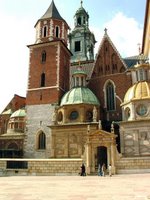While the Memsahib’s been plugging away at learning Polish, and getting pretty grumpy in the process I might add, I’ve been quietly pottering about and getting everything I want without having to utter a sound, let alone attempt the teeth-juddering oral contortions required to speak the local lingo. I’ve managed to travel around the world in my time without having to resort to all that foreign gobbledegook. We chaps, y’see, can manage without words. It’s quite simple: life (for men, anyway) is simply made up of needs. Bodily needs. Food, drink, … er … and one or two other things. Now, it’s simply a question of working out a simple visual signal which conveys this need without (and this is crucial) making a fool of oneself. What is remarkable is that, without the aid of teachers or dictionaries, this sign language has evolved independently throughout the world, in places as diverse as Tibet and Tonbridge, Kingston Jamaica and Kingston-upon-Thames, and is identical wherever you go!!
Let’s take ordering a drink – pretty high in most chaps’ list of priorities, I would say. Chap goes into bar. Chap walks around bar for a bit (purpose of this will become apparent later). Chap sits at bar and marks his territory by placing his property strategically on the bar: smoking accoutrements, mobile phone (a present from Daphne so she can keep tabs on me – I keep it switched off, of course). Chap makes eye contact with barman. (Eye contact is a vital element of international chap talk – without it you wouldn’t know who you’re not talking to). Chap raises finger, to indicate he requires a libation. Barman lifts his head and eyebrows slightly, to indicate he is listening. Chap also lifts eyebrows. If Chap is known to Barman, this means “The usual, John”. (Very important point in non-verbal bar talk – once you’ve established your tipple, NEVER SWITCH TO A NEW DRINK). (And barmen are always called John). If Chap is new to Barman, this means “Mine’s a pint of your best ale, please, goodly innkeeper”.
After the initial contact, Chap can sit all night at a bar, obtaining a steady stream of libations without uttering a word. When glass is empty, establish eye contact again and nod. If you need an ashtray, mime tapping ash off a cigarette. Barman will understand perfectly. With luck, small talk with fellow drinkers will be limited to lending them your matches (Fellow Drinker waves cigarette at Chap, Chap hands over matchbox, Fellow Drinker returns matchbox with a nod and a smile, Chap returns nod without a smile) or the occasional exchange of admiring glances if a particularly handsome filly trots past. To be on the safe side, Chap could always take an English newspaper and pretend to be doing the crossword. If Chap is a non-smoker, of course, life is even easier.
At some point Chap will need to answer the call of nature. The location of the facilities will have been established on the initial recce, to avoid the need to ask (and thereby risk looking silly). In order not to lose seat, and with it face, Chap leaves half-drunk pint and smoking accoutrements on bar. If the facilities are communal, Chap observes unwritten rule of lavatorial etiquette, which involves whistling, humming, clearing throat and other vocal (but not verbal) indications of territoriality. The tune whistled (I favour the Dambusters myself) and the depth of throat-clearing are designed to signal to other occupants that, in the event Chap has inadvertantly interrupted a private conversation, he will be on his way as soon as his business is finished.
When Chap feels he’s had enough and it’s time to wobble off home, establish eye contact once more with Barman (although it could be a bit difficult, as Chap might be seeing two, or even three, of him by now) and mime writing something down, using left hand as a writing pad and holding an imaginary pen in the right. Of course, if Chap is left-handed he can do it the other way round. This means: “I shay, ole shap, how mush do I owe?” Barman will nod and, after about 20 minutes and a few more reminders with the writing pad, will bring a piece of paper which Chap does not need to look at as he will not be able to focus on all the zeros anyway. Chap produces large denomination banknote and, if Barman does not look angry or impatient, makes a magnanimous sweeping-away gesture with his hand, indicating “Keep the change, my good fellow”. This will avoid Chap having to remonstrate with Barman about being over-charged and risking making a fool of himself. If Barman does look angry or impatient, Chap should check that the banknote is in fact legal tender in the country, and throw any empty change from his pockets onto the bar nonchalantly before nodding in a decisive manner (meaning “Thank you show mush for your good shervishes, my man, shee you again neksht week”) and striding off into the wall, and eventually through the door, leaving his smoking accoutrements and mobile phone on the bar.
At this point Chap will require locomotion in a homeward direction. Hopefully there will be a taxi rank not far from the inn. This can be recognized by a group of blurry white lights with cars underneath them, although do check they are marked “taxi” and not “policja”. This is where a little of the local parley-voo is unavoidable. All you have to remember is the name of your street. Don’t worry about numbers – in Polish, 44 sounds just like 36 or 29 and will only confuse matters. If you live near the corner of another street, you can add the name of the adjoining street preceded by “od”. If you don’t, or if you can’t remember where you live, let the cabbie work it out while you fall asleep in the back of the taxi. Remarkably, when you wake up you will be at your front door. Throw another large denomination note at the driver before falling onto the pavement.
It is interesting how non-verbal communication only works between men. When you get in the house and attempt to convey to Her Indoors with a jaunty step and a bright smile that you are perfectly sober, She always accuses you of being drunk and of kicking the cat. If only women had the intuitive powers of us men.



